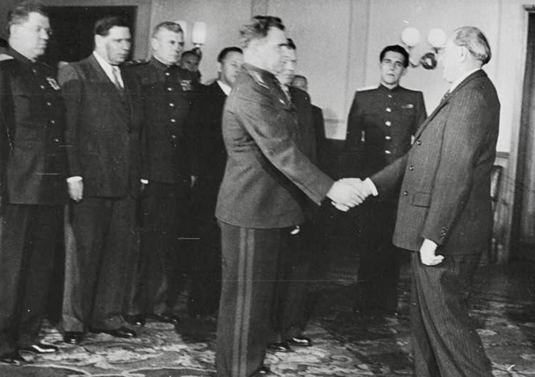Torgau and Tempelhof: 25-26 April 1945
- Maria A. Kithcart

- Apr 19, 2022
- 2 min read
Updated: Apr 30, 2024

Pictured (clockwise): Photo of American and Red Army officers and soldiers meeting on the Elbe River near Torgau; Colonel-General V. I. Chuikov’s signature on a characteristic review form, signed 25 April 1945; the reverse side of the Elbe River meeting photograph dated 25 April 1945; the front view of a battle characteristic review for Colonel Sergey Borisovich Vil’din, a Belarussian who served in Lieutenant-General Pozharsky’s artillery of the 8th Guards Army.
The Second World War began in 1939 with the German invasion of Poland in September. For the Soviets, the Great Patriotic War began 22 June 1941 when the Germans invaded the USSR in Operation Barbarossa. Four years later in late April 1945, Marshal Zhukov’s 1st Belorussian Front and Marshal Konev’s 1st Ukrainian Front were racing to capture Berlin to end the war in Europe. Soldiers from the 1st Ukrainian Front encountered American troops east of Torgau on the Elbe River for the famous “East Meets West” event on 25 April 1945. The next day, Commander Chuikov’s 8th Guards Army of the 1st Belorussian Front captured the Tempelhof Airport in Berlin with the intent of preventing upper-level Nazis from leaving the city by air. Marshal Chuikov wrote about the importance of taking Tempelhof in his work titled From Stalingrad to Berlin:
“It must be said that the capture of Tempelhof airport was very important for the entire battle for Berlin. It was the last platform in Berlin from which planes could take off. And of course, the enemy did everything to keep in his hands this only window into the air. The airfield was defended by anti-aircraft units, Waffen-SS detachments, and tanks placed with a bracket along the border of the take-off field from the south and east. Most of the tanks were buried in the ground and turned into fixed firing points. Apparently, the Berlin garrison was left without fuel reserves for tanks: all gasoline, as shown by captured tankers, was taken by pilots for aircraft.
According to the testimony of the prisoners, in the underground hangars there were planes, fully refueled, ready for takeoff at any minute. They had crews on duty around the clock, and they included pilots and navigators who in the past were trusted to airlift Hitler, […] Goebbels, Bormann, and other leaders of the Third Reich. It could be concluded that Hitler and his associates were still in Berlin. We couldn't let them slip through that single window! Regiments of the 39th and 79th Guards Rifle Divisions were tasked with encircling the airfield. The gunners were ordered to keep the take-off pads under fire. We didn't know the exact coordinates of the exit gates from the underground hangars, so the assault squads, reinforced by tanks, aimed to cut with the fire of machine guns the runways and thus block the aircraft underground.
The plan could not have been better. Not a single plane had taken off there since the evening of 25 April. By noon on 26 April, the airfield and the entire Tempelhof airport, with hangars and communication centers, including the main building Flughafen, were in our hands.”



